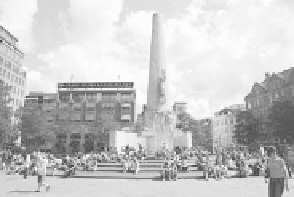Travel Reference
In-Depth Information
ha rbor”—for sea traff ff ic)
from the
rokin
(“ i n n e r
harbor”—for river traff ic).
Land trade routes con-
verged here as well, and a
customs house stood in this
spot. Today, the Damrak
and Rokin (roh-KEEN) are
major roads, and the city's
palace and major department stores face the square, where mimes,
jugglers, and human statues mingle with locals and tourists. This
is the historic heart of the city. As the symbolic center of the
Netherlands, it's where political demonstrations begin and end.
Pan the square clockwise to see the following: the Royal
Palace (the large domed building on the west side), the New
Church (Nieuwe Kerk), Nieuwendijk (a pedestrian-only shop-
ping street running parallel to Damrak and stretching all the way
to Central Station), Damrak, the proud old De Bijenkorf (“The
Beehive”) department store (with a recommended café—see
page 186), the Grand Hotel Krasnapolsky (with its fine circa-
1900 Winter Garden), the white phallic obelisk of the National
Monument, Rokin street (Damrak's counterpart, continuing past
the square), touristy and overpriced Madame Tussauds, and the
entrance to the pedestrian-only shopping street, Kalverstraat
(look for
Rabobank
sign).
Royal Palace
The name is misleading, since Amsterdam is one of the cradles
of modern democracy. For centuries, this was the Town Hall of
a self-governing community
that prided itself on its inde-
pendence and thumbed its
nose at royalty. The current
building, built in about 1650,
is appropriately classical (like
the democratic Greeks), with
a triangular pediment fea-
turing—fittingly for Amster-
dam—denizens of the sea
cavorting with Neptune (with his green copper trident).
After the city was conquered by the French, Napoleon
imposed a monarchy on Holland, making his brother Louis the
king of the Netherlands (1808). Louis used the city hall as his “royal
palace,” giving the building its current name. When Napoleon
was defeated, the victorious powers dictated that the Netherlands
remain a monarchy, under a noble Dutch family called the House






















